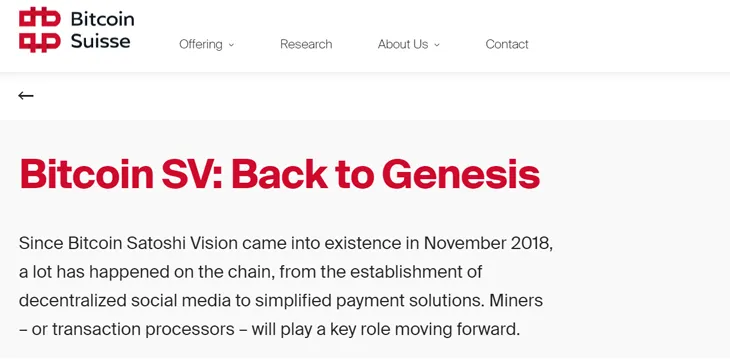|
Getting your Trinity Audio player ready...
|
Recent research from Bitcoin Suisse took a deep dive into the original Bitcoin (BSV). The research thoroughly explored Bitcoin and stated that “it is worth to take a look through the social media-driven smokescreen and pay attention to the diverse developments happening right now” in Bitcoin SV.
Why Bitcoin is valuable
We encourage you to read the full research report, but here are a few excerpts from the research that show why there is so much value in BSV and that indicates why Bitcoin SV is currently undervalued:
“Bitcoin Satoshi Vision, the fifth largest cryptocurrency by market capitalization (excluding Tether), was created as a fork of Bitcoin Cash (which is a fork of BTC) on November 15, 2018 at block number 556766.”
Contrary to media reports, BTC and BCH both forked away from the original Bitcoin protocol by making changes to Satoshi’s design, and it is only Bitcoin SV that has continued the original Bitcoin protocol. BTC developers forked off in August 1, 2017 when they integrated Segregated Witness into their node software, while BCH protocol developers deviated from Bitcoin’s original design when they integrated Canonical Transaction Ordering (CTOR) and OP_checkdatasig into their node software on November 15, 2018—this is why they’re no longer considered Bitcoin.
“Since Bitcoin Satoshi Vision came into existence in November 2018, a lot has happened on the chain, from the establishment of decentralized social media to simplified payment solutions.”
Since its creation, BSV has seen a lot of development in both the b2b and b2c space. From innovative consumer-facing products coming from RelayX and Float SV to tools aimed at software developers like sCrypt to social media networks that allow users to earn revenue like Twetch, the Bitcoin network has made great strides since the day it was created.
“The Genesis hard fork, among other changes, restored the functionality of OP_RETURN in the Bitcoin scripting language, which allows it to terminate scripts early. Additionally, pay-to-script-hash (P2SH), which is often used in BTC for multi-signature wallets, is no longer available as an option for new outputs. BSV’s last hard fork will be called Chronicle and mark the move back to Bitcoin’s original difficulty adjustment algorithm (every 2016 blocks) instead of the one inherited from BCH, which adjusts the difficulty for each block based on a moving average of block times in the last 144 blocks… The largest block mined so far on BSV was 256 MB large and was added to the chain in July 2019 during a mainnet stress test. In the long run, the goal is to produce terabyte-sized blocks and overcome potential propagation issues that might arise.”
The Genesis protocol upgrade restored the Bitcoin protocol back to ‘as close as possible’ to the original design when it went live in 2009. Among the changes, the Genesis hard fork removed P2SH as well as block size limits. The Genesis upgrade also restored the original Bitcoin script language. Since Genesis, the BSV network continually sees blocks over 5MB in size. The final upgrade to the BSV network will be the Chronicle upgrade, which will restore the difficulty algorithm to an adjustment every 2016 blocks.
“This scalability approach also has the longer-term goal to shift miner revenues from block rewards to transaction fees. While in BTC, individual transactions are supposed to become more valuable to the user, e.g. opening a channel in the Lightning Network that could then be used many times, BSV is instead focusing on growing the overall transaction volume to increase revenues from fees…The new model of viewing miners as transaction processors means that miners have predefined volume-based contracts with parties that are interested in conducting a lot of transactions each day.”
Now that the BTC halving has taken place and the BTC block reward was reduced from 12.5 to 6.25, the block reward alone will not be enough for many BTC miners to stay cash-flow positive. That being said, instead of shutting off their mining hardware completely, miners will most likely point their hash power at a chain that is more profitable and rich with transactions and transaction fees. BSV focuses on being that chain; by removing the block size limit, which makes the potential block sizes and their accompanying fees limitless.
Bitcoin (BSV) to the moon! pic.twitter.com/I3GOT3KdfX
— Stein H Ludvigsen – Bitcoinˢᵛ (@SteinLudvigsen) May 13, 2020
In conclusion
The body of the research conducted by Bitcoin Suisse is very well put together, however, there is one element of the Bitcoin Suisse conclusion that we do not agree with:
“Overall, the direction that BSV takes for its base layer – e.g. aiming to serve as a regulatory compliant infrastructure provider for big corporations – compared to BTC strongly reflects the different mindset between the two communities…In spite of the ongoing, at times heated and unconstructive discussion of which approach is “better”…it is worth taking a look through the social media-driven smokescreen and paying attention to the diverse developments happening right now. In the end, the free market will be the judge of how to value each concept.”
The reason we do not agree with the conclusion is because BTC and BSV do not compete.
In fact, BSV really has no competitors for its two super powers—micropayments and immutable data storage on a public blockchain—because it’s the only one that massively scales and this scaling is patent protected. All application development that needs enterprise level scaling can only work on BSV.
The BTC network does not try to do these things, because these things are not possible on BTC ever since the Core developers changed the underlining protocol. The BTC network is known to have high transaction fees at times where the network experiences a significant amount of traffic; this makes BTC unsuitable for micropayments. In addition, the BTC block size limit prevents users from easily writing and storing data to the BTC blockchain.
The BTC network does not have businesses or consumers using it every day and trying to create more value on top of it. Instead, individuals tend to use BTC as a speculative financial instrument that they hope will appreciate in value without them putting in any utility. And by the looks of it, BTC has no plans to change that. This shows why BSV and BTC are not as similar or in competition as many people (wrongfully) think they are.
It is a mistake to compare BSV to other platforms that have no interest or ability to scale and service these two massive global markets. BSV owns this space globally now—and is unstoppable as a result. No amount of mudslinging can change this fact and the community of bright young developers and entrepreneurs who understand this is big enough and growing fast enough that all the FUD does is slow things down a bit as some are temporarily confused. This is over now and BSV won already in its two targeted areas with its two super powers.
What Bitcoin Suisse did get right in their conclusion, is that when you look past the banter and ad-hominem against BSV that floods social media and cryptocurrency publications, you will realize that you have a blockchain, where real value is being added to the chain each and every day—that is more than worth it to take a look at.

 07-14-2025
07-14-2025 





